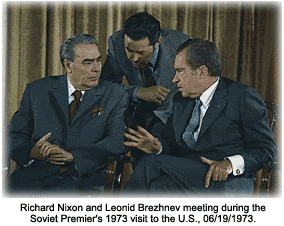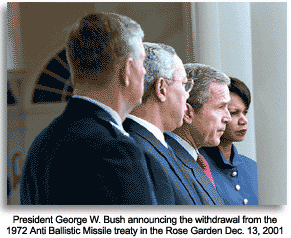In a world where the military balance between superpowers depended on "mutually assured destruction," defensive measures could become provocative. Advances in technology in the 1960s resulted in serious proposals for an anti-ballistic missile (ABM) system to protect the United States against Inter-Continental Ballistic Missile (ICBM) attacks. The Soviets installed an ABM system around Moscow. In order to prevent an expensive race to develop still more destructive offensive weapons, the United States and the Soviet Union agreed to the Anti-Ballistic Missile Treaty in 1972. The United States withdrew from the treaty unilaterally in 2002 in the wake of terrorist attacks on the World Trade Center and the Pentagon.
Through research that developed the Nike Zeus missile system, the United States obtained technology that could be modified to produce a form of anti-ballistic missile defense. A missile called Sprint was developed for that purpose and a nationwide system known as Sentinel was proposed to deploy it.
There was considerable public criticism of the plan. Doubts were cast on the technological feasibility of the system and it was pointed out that if the Soviet Union felt strategically threatened by the imbalance that would result, they might be tempted to launch a first strike against the United States before Sentinel could be deployed.
Meanwhile, a development in ICBM technology, the multiple, independently-targetable re-entry vehicle or MIRV, changed the economics of an ABM defense dramatically. Since one incoming ICBM could now send out 10 warheads, each of which would require an ABM missile to destroy it, the attacking nation could afford to send enough ICBMs to overwhelm any ABM defense erected against it.
 As the futility of the process became apparent to both sides, the need for a treaty limiting ABM developments arose. Limiting both ABMs and the offensive nuclear weapons became the objective of the Strategic Arms Limitation Talks (SALT) that ran from 1969 to 1972. Out of those talks came the Anti-Ballistic Missile Treaty and the Interim Agreement. Both were signed in Moscow on May 26, 1972.
The ABM Treaty specified that each nation was allowed two widely spaced ABM systems, one of which could defend the national capital. The treaty was the first to allow for the non-interference of the other nation to verify the adherence to the treaty by the other and established the Standing Consulting Commission to air compliance concerns. In 1974, the treaty was amended to reduce the number to one apiece. The Soviet Union deployed a system around Moscow. The United States selected its ICBM sites near Grand Forks, North Dakota, for ABM protection, but dropped the idea soon after its deployment, due to high costs and doubts of its effectiveness.
The fundamental premise of the ABM Treaty was that each nation would leave unchallenged the ability of the other to penetrate its territory with strategic weapons, thus preserving mutually assured destruction. When President Ronald Reagan announced the Strategic Defense Initiative (SDI), better known as :"Star Wars," the Soviets objected that it was a violation of the ABM Treaty. The U.S. did not withdraw from the treaty, however, and SDI never met its design objectives.
Since the treaty was between the United States and the Soviet Union, the status of the ABM Treaty became unclear after the breakup of the Soviet Union in 1991. Eventually in 1997, a memorandum of understanding was signed between the United States and four of the former Soviet republics, but it was never presented to the U.S. Senate for ratification.
As the futility of the process became apparent to both sides, the need for a treaty limiting ABM developments arose. Limiting both ABMs and the offensive nuclear weapons became the objective of the Strategic Arms Limitation Talks (SALT) that ran from 1969 to 1972. Out of those talks came the Anti-Ballistic Missile Treaty and the Interim Agreement. Both were signed in Moscow on May 26, 1972.
The ABM Treaty specified that each nation was allowed two widely spaced ABM systems, one of which could defend the national capital. The treaty was the first to allow for the non-interference of the other nation to verify the adherence to the treaty by the other and established the Standing Consulting Commission to air compliance concerns. In 1974, the treaty was amended to reduce the number to one apiece. The Soviet Union deployed a system around Moscow. The United States selected its ICBM sites near Grand Forks, North Dakota, for ABM protection, but dropped the idea soon after its deployment, due to high costs and doubts of its effectiveness.
The fundamental premise of the ABM Treaty was that each nation would leave unchallenged the ability of the other to penetrate its territory with strategic weapons, thus preserving mutually assured destruction. When President Ronald Reagan announced the Strategic Defense Initiative (SDI), better known as :"Star Wars," the Soviets objected that it was a violation of the ABM Treaty. The U.S. did not withdraw from the treaty, however, and SDI never met its design objectives.
Since the treaty was between the United States and the Soviet Union, the status of the ABM Treaty became unclear after the breakup of the Soviet Union in 1991. Eventually in 1997, a memorandum of understanding was signed between the United States and four of the former Soviet republics, but it was never presented to the U.S. Senate for ratification.
 That became completely moot when President George W. Bush declared the intention of the United States to withdraw from the treaty in December 2001 because of the terrorist attacks on September 11 of the same year. Although the treaty had been of indefinite duration, he invoked the provision that allowed a party to withdraw if exceptional circumstances dictated the decision. Bush declared that the U.S. needed to provide a defense, not against the Russians because they are U.S. allies, but against "rogue states," who might want to attack the United States. Such countries as Iran and North Korea were actively pursuing a system of weapons of mass destruction against which Bush had proposed a defensive system. He explained that the ABM Treaty was a relic from the Cold War era and that:
That became completely moot when President George W. Bush declared the intention of the United States to withdraw from the treaty in December 2001 because of the terrorist attacks on September 11 of the same year. Although the treaty had been of indefinite duration, he invoked the provision that allowed a party to withdraw if exceptional circumstances dictated the decision. Bush declared that the U.S. needed to provide a defense, not against the Russians because they are U.S. allies, but against "rogue states," who might want to attack the United States. Such countries as Iran and North Korea were actively pursuing a system of weapons of mass destruction against which Bush had proposed a defensive system. He explained that the ABM Treaty was a relic from the Cold War era and that:
"The Cold War is long gone. Today we leave behind one of its last vestiges. But this is not a day for looking back. This is a day for looking forward with hope and anticipation of greater prosperity and peace for Russians, for Americans and for the entire world."The Russians were unhappy but not concerned about the withdrawal. In response to Bush’s move to abandon the treaty, Russian President Vladimir Putin said that it was a “mistake” and that both countries should proceed expeditiously to create a "new framework of our strategic relationship.” In June 2002, following the necessary six months notice, the United States withdrew and the ABM Treaty became defunct.